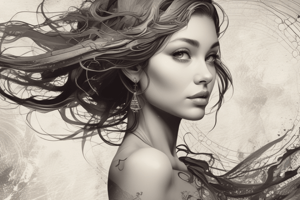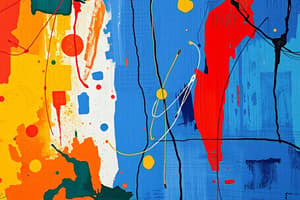Podcast
Questions and Answers
What is the main role of texture in enhancing visual art?
What is the main role of texture in enhancing visual art?
- Conveying only emotions in the artwork
- Creating a 2D visual effect
- Adding colors to the artwork
- Providing depth and engaging the senses of the viewer (correct)
Which technique in painting involves applying thick layers of paint onto the canvas?
Which technique in painting involves applying thick layers of paint onto the canvas?
- Dry Brushing
- Impasto Technique (correct)
- Mixed Media
- Modeling
What is the purpose of dry brushing in painting?
What is the purpose of dry brushing in painting?
- Removing excess paint
- Creating a smooth surface
- Adding texture to specific areas (correct)
- Mixing colors
What can be used to create interesting textures in mixed media painting?
What can be used to create interesting textures in mixed media painting?
What is the main difference between texture in painting and sculpture?
What is the main difference between texture in painting and sculpture?
What is the purpose of carving in sculpture?
What is the purpose of carving in sculpture?
What can be used to create a textured surface in sculpture?
What can be used to create a textured surface in sculpture?
What is the ultimate goal of experimenting with texture in art?
What is the ultimate goal of experimenting with texture in art?
What is the purpose of incorporating various materials in sculpture?
What is the purpose of incorporating various materials in sculpture?
What technique is used to capture fine details in a subject in photography?
What technique is used to capture fine details in a subject in photography?
How can you enhance texture in photography during post-processing?
How can you enhance texture in photography during post-processing?
What is a key benefit of incorporating texture in art?
What is a key benefit of incorporating texture in art?
What is a common technique used in textile art to create textures?
What is a common technique used in textile art to create textures?
What is the purpose of layering fabrics in textile art?
What is the purpose of layering fabrics in textile art?
What is a key consideration when working with texture in different art forms?
What is a key consideration when working with texture in different art forms?
What is the result of incorporating texture in art?
What is the result of incorporating texture in art?
What can be used to add contrasting textures and visual interest to a sculpture?
What can be used to add contrasting textures and visual interest to a sculpture?
How can texture be effectively conveyed in photography?
How can texture be effectively conveyed in photography?
What is the purpose of using macro photography in texture photography?
What is the purpose of using macro photography in texture photography?
How can the textures found in a photograph be enhanced during post-processing?
How can the textures found in a photograph be enhanced during post-processing?
What is a technique used in textile art to create textures on fabric?
What is a technique used in textile art to create textures on fabric?
What is the purpose of incorporating different fabrics with different textures in quilting?
What is the purpose of incorporating different fabrics with different textures in quilting?
Why is it important to experiment with texture in different art forms?
Why is it important to experiment with texture in different art forms?
What is the key benefit of incorporating texture in art?
What is the key benefit of incorporating texture in art?
What is the primary effect of using impasto technique in painting?
What is the primary effect of using impasto technique in painting?
What is the purpose of using dry brushing in painting?
What is the purpose of using dry brushing in painting?
Which technique is suitable for adding texture to specific areas in a painting?
Which technique is suitable for adding texture to specific areas in a painting?
What is the result of carving the surface of a sculpture?
What is the result of carving the surface of a sculpture?
What is the primary difference between texture in painting and sculpture?
What is the primary difference between texture in painting and sculpture?
Which medium allows artists to experiment with texture in three dimensions?
Which medium allows artists to experiment with texture in three dimensions?
What is the purpose of incorporating unconventional materials in mixed media painting?
What is the purpose of incorporating unconventional materials in mixed media painting?
What is the primary goal of experimenting with texture in different art forms?
What is the primary goal of experimenting with texture in different art forms?
Flashcards are hidden until you start studying
Study Notes
Texture in Visual Art
- Texture plays a crucial role in enhancing visual art, providing depth, and engaging the viewer's senses.
- Artists use texture to create various effects, add interest, and convey emotions or ideas in their works.
Texture in Painting
- Impasto technique involves applying thick layers of paint to create a textured surface, adding depth and dimension to the artwork.
- Mixed media can create interesting textures by incorporating materials like sand, fabric, or paper onto the canvas.
- Dry brushing involves using a dry brush with little paint to create rough and textured strokes, suitable for adding texture to specific areas or highlighting details.
Texture in Sculpture
- Carving involves using tools to create textures such as lines, grooves, or patterns on the surface of the sculpture.
- Modeling involves building up layers of clay or other materials to create a textured surface, experimenting with different tools and techniques.
- Incorporating mixed materials, such as metal, wood, or fabric, can add contrasting textures and visual interest to a sculpture.
Texture in Photography
- Macro photography captures fine details in a subject, conveying texture through composition and lighting.
- Choosing backgrounds or surfaces with interesting textures can complement and emphasize the main subject.
- Post-processing editing software can enhance and accentuate textures found in photographs, adjusting contrast, clarity, and sharpness.
Texture in Textile Art
- Embroidery involves experimenting with different stitches to create textures on fabric, mixing stitches like French knots, satin stitches, or couching.
- Appliqué combines different fabric textures by layering them onto the main fabric, creating depth and visual interest.
- Quilting incorporates various fabrics with different textures, playing with fabric placements to add visual and tactile variety.
Practical Application of Texture
- Experimenting and exploring different textures is crucial to finding what works best for an artistic vision.
- Incorporating texture can elevate art, engage the viewer's senses, and create visually captivating works of art.
Texture in Visual Art
- Texture plays a crucial role in enhancing visual art, providing depth, and engaging the viewer's senses.
- Artists use texture to create various effects, add interest, and convey emotions or ideas in their works.
Texture in Painting
- Impasto technique involves applying thick layers of paint to create a textured surface, adding depth and dimension to the artwork.
- Mixed media can create interesting textures by incorporating materials like sand, fabric, or paper onto the canvas.
- Dry brushing involves using a dry brush with little paint to create rough and textured strokes, suitable for adding texture to specific areas or highlighting details.
Texture in Sculpture
- Carving involves using tools to create textures such as lines, grooves, or patterns on the surface of the sculpture.
- Modeling involves building up layers of clay or other materials to create a textured surface, experimenting with different tools and techniques.
- Incorporating mixed materials, such as metal, wood, or fabric, can add contrasting textures and visual interest to a sculpture.
Texture in Photography
- Macro photography captures fine details in a subject, conveying texture through composition and lighting.
- Choosing backgrounds or surfaces with interesting textures can complement and emphasize the main subject.
- Post-processing editing software can enhance and accentuate textures found in photographs, adjusting contrast, clarity, and sharpness.
Texture in Textile Art
- Embroidery involves experimenting with different stitches to create textures on fabric, mixing stitches like French knots, satin stitches, or couching.
- Appliqué combines different fabric textures by layering them onto the main fabric, creating depth and visual interest.
- Quilting incorporates various fabrics with different textures, playing with fabric placements to add visual and tactile variety.
Practical Application of Texture
- Experimenting and exploring different textures is crucial to finding what works best for an artistic vision.
- Incorporating texture can elevate art, engage the viewer's senses, and create visually captivating works of art.
Studying That Suits You
Use AI to generate personalized quizzes and flashcards to suit your learning preferences.




